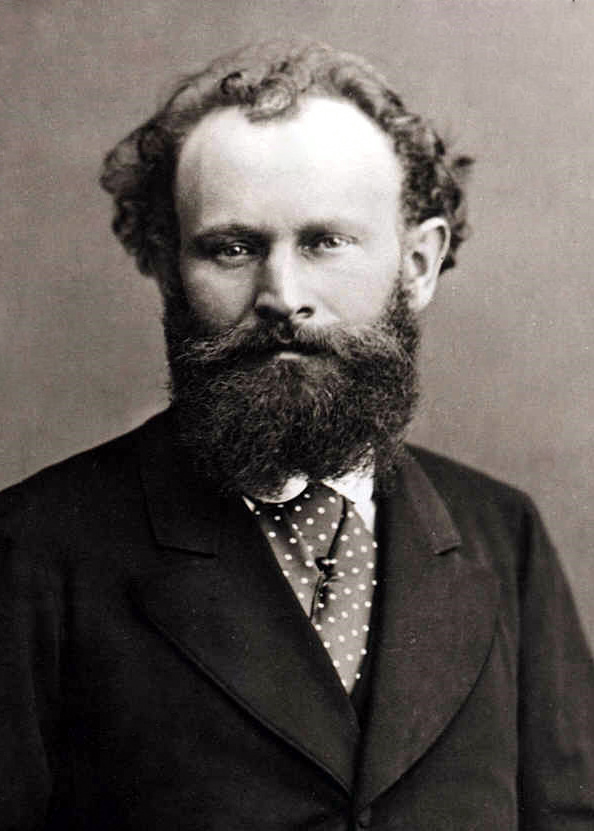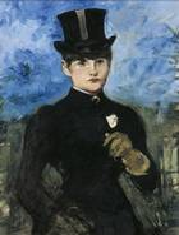 Edouard Manet est à l’honneur. Le musée d’Orsay vient de lui consacrer, du 5 avril au 17 juillet 2011, une magistrale exposition avec 181 de ses tableaux dont Le Déjeuner sur l’herbe, Le Joueur de fifre et Olympia. C’est un peu tard pour vous en parler, me direz-vous ! Certes, mais, l’affluence était telle que, sauf à stagner des heures dans des files d’attente sans fin, je n’ai pu visiter cette expo que la veille de sa clôture. Pourtant, laissez-moi vous souligner quelques traits majeurs de ce peintre magnifique qui su ouvrir l’art pictural au modernisme et à l’impressionnisme. Issu d’une famille bourgeoise, Edouard Manet (1832-1883) est attiré par une carrière artistique et voyage en Europe : Hollande, Allemagne, Autriche et Italie. Il fréquente Baudelaire, Zola, Delacroix ou Mallarmé. Il commence à exposer… Certains de ses tableaux font sensation et scandale, comme ce traitement particulier de la couleur, dont ce blanc discret et dilué, une des caractéristiques majeures de son style pictural. L’artiste se montre, également, très sensible à la diversité de sa ville. En observateur attentionné, il fait des lieux qu’il fréquente, les sujets de ses toiles – théâtres et opéra de Paris, cabarets, bars et cafés… – Il n’hésite pas, non plus, à témoigner des côtés obscurs de la cité – pauvreté des clochards, des invalides, prostitution sordide -.. En 1865, fasciné par l’art ibérique, il séjourne à Madrid. Puis, après la guerre de 1870, il installe un nouvel atelier à Pigalle, comme Degas, Renoir, Monet et Pissarro. En 1875, Edouard Manet expose au Salon Argenteuil. La presse en fait, alors, le chef de l’école impressionniste. Mais il est souvent critiqué, sa santé se détériore et il meurt en 1883. Edouard Manet, inventeur du Moderne se situe clairement entre l’héritage du romantisme et l’impact de son époque. L’exposition qui vient de s’achever au Musée d’Orsay, a parfaitement bien repensé tout le parcours du peintre, avec, notamment, ses liens avec la sphère publique et politique, la réforme de l’art religieux, l’imaginaire érotique, l’art du fragment, le rapport à la peinture féminine, la tentation mondaine, ou, encore, sa complicité avec le Mallarmé le plus noir. En résumé, ce fut une belle manifestation artistique pour un très grand peintre. Un de ces évènements culturels dont Paris a le secret, même si s’ébruitant, ce dernier attire des foules invraisemblables m’ayant contraint à quelques retards pour vous le rapporter…
Edouard Manet est à l’honneur. Le musée d’Orsay vient de lui consacrer, du 5 avril au 17 juillet 2011, une magistrale exposition avec 181 de ses tableaux dont Le Déjeuner sur l’herbe, Le Joueur de fifre et Olympia. C’est un peu tard pour vous en parler, me direz-vous ! Certes, mais, l’affluence était telle que, sauf à stagner des heures dans des files d’attente sans fin, je n’ai pu visiter cette expo que la veille de sa clôture. Pourtant, laissez-moi vous souligner quelques traits majeurs de ce peintre magnifique qui su ouvrir l’art pictural au modernisme et à l’impressionnisme. Issu d’une famille bourgeoise, Edouard Manet (1832-1883) est attiré par une carrière artistique et voyage en Europe : Hollande, Allemagne, Autriche et Italie. Il fréquente Baudelaire, Zola, Delacroix ou Mallarmé. Il commence à exposer… Certains de ses tableaux font sensation et scandale, comme ce traitement particulier de la couleur, dont ce blanc discret et dilué, une des caractéristiques majeures de son style pictural. L’artiste se montre, également, très sensible à la diversité de sa ville. En observateur attentionné, il fait des lieux qu’il fréquente, les sujets de ses toiles – théâtres et opéra de Paris, cabarets, bars et cafés… – Il n’hésite pas, non plus, à témoigner des côtés obscurs de la cité – pauvreté des clochards, des invalides, prostitution sordide -.. En 1865, fasciné par l’art ibérique, il séjourne à Madrid. Puis, après la guerre de 1870, il installe un nouvel atelier à Pigalle, comme Degas, Renoir, Monet et Pissarro. En 1875, Edouard Manet expose au Salon Argenteuil. La presse en fait, alors, le chef de l’école impressionniste. Mais il est souvent critiqué, sa santé se détériore et il meurt en 1883. Edouard Manet, inventeur du Moderne se situe clairement entre l’héritage du romantisme et l’impact de son époque. L’exposition qui vient de s’achever au Musée d’Orsay, a parfaitement bien repensé tout le parcours du peintre, avec, notamment, ses liens avec la sphère publique et politique, la réforme de l’art religieux, l’imaginaire érotique, l’art du fragment, le rapport à la peinture féminine, la tentation mondaine, ou, encore, sa complicité avec le Mallarmé le plus noir. En résumé, ce fut une belle manifestation artistique pour un très grand peintre. Un de ces évènements culturels dont Paris a le secret, même si s’ébruitant, ce dernier attire des foules invraisemblables m’ayant contraint à quelques retards pour vous le rapporter…
Manet the Modern
 Edouard Manet is in vogue. The Musée d’Orsay dedicated a wonderful exhibition to him from 5th April to 17th July 2011, with 181 of his paintings including Luncheon on the Grass, The Fifer and Olympia. It’s a bit late to tell you about it, you say! Clearly, but it was so crowded that, without enduring hours in the endless queues, I was only able to visit this exhibition the day before it closed. However, let me highlight for you some major features of this magnificent painter, who knew how to open up pictorial art to modernism and impressionism. From a bourgeois family, Edouard Manet (1832-1883) was attracted to a career in art and travel in Europe: Holland, Germany, Austria and Italy. Baudelaire, Zola, Delacroix and Mallarmé were among his associates. He began to exhibit. Some of his paintings were sensational and scandalous, like this particular treatment of colour including this subtle and dilute white, one of the major characteristics of his pictorial style. The artist also proved very sensitive to the diversity of his city. As an attentive observer, he made the places he frequented the subjects of his paintings, the theatres and opera of Paris, cabarets, bars, cafes, etc. He didn’t hesitate, either, in showing the dark sides of the city: the poverty of tramps, cripples, sordid prostitution. In 1865, fascinated with Iberian art, he travelled to Madrid. Then, after the war in 1870, he set up a new studio in Pigalle, like Degas, Renoir, Monet and Pissarro. In 1875, Edouard Manet had an exhibition at the Salon Argenteuil. The press, in fact, appointed him leader of the school of Impressionism. But he was often criticised, his health deteriorated and he died in 1883. Edouard Manet, inventor of the Modern, is clearly positioned between the heritage of Romanticism and the impact of his period. The exhibition that just finished at the Musée d’Orsay was a perfect retrospective of the painter’s career, specifically with his connections to the public and political spheres, the reform of religious art, erotic imagery, the art of the fragment, the relationship to female painting, the temptations of high society, and even his complicity with Mallarmé at his darkest. In summary, this was a beautiful artistic display for a great painter. One of these cultural events to which Paris has the secret, even if it is getting out, it attracts unbelievable crowds, which delayed my reporting on it on several occasions.
Edouard Manet is in vogue. The Musée d’Orsay dedicated a wonderful exhibition to him from 5th April to 17th July 2011, with 181 of his paintings including Luncheon on the Grass, The Fifer and Olympia. It’s a bit late to tell you about it, you say! Clearly, but it was so crowded that, without enduring hours in the endless queues, I was only able to visit this exhibition the day before it closed. However, let me highlight for you some major features of this magnificent painter, who knew how to open up pictorial art to modernism and impressionism. From a bourgeois family, Edouard Manet (1832-1883) was attracted to a career in art and travel in Europe: Holland, Germany, Austria and Italy. Baudelaire, Zola, Delacroix and Mallarmé were among his associates. He began to exhibit. Some of his paintings were sensational and scandalous, like this particular treatment of colour including this subtle and dilute white, one of the major characteristics of his pictorial style. The artist also proved very sensitive to the diversity of his city. As an attentive observer, he made the places he frequented the subjects of his paintings, the theatres and opera of Paris, cabarets, bars, cafes, etc. He didn’t hesitate, either, in showing the dark sides of the city: the poverty of tramps, cripples, sordid prostitution. In 1865, fascinated with Iberian art, he travelled to Madrid. Then, after the war in 1870, he set up a new studio in Pigalle, like Degas, Renoir, Monet and Pissarro. In 1875, Edouard Manet had an exhibition at the Salon Argenteuil. The press, in fact, appointed him leader of the school of Impressionism. But he was often criticised, his health deteriorated and he died in 1883. Edouard Manet, inventor of the Modern, is clearly positioned between the heritage of Romanticism and the impact of his period. The exhibition that just finished at the Musée d’Orsay was a perfect retrospective of the painter’s career, specifically with his connections to the public and political spheres, the reform of religious art, erotic imagery, the art of the fragment, the relationship to female painting, the temptations of high society, and even his complicity with Mallarmé at his darkest. In summary, this was a beautiful artistic display for a great painter. One of these cultural events to which Paris has the secret, even if it is getting out, it attracts unbelievable crowds, which delayed my reporting on it on several occasions.
Didier MOINEL DELALANDE









Un commentaire pour “Manet le Moderne”